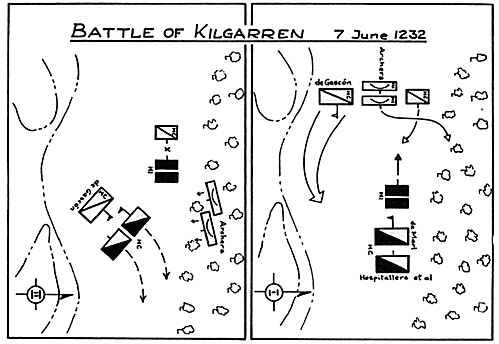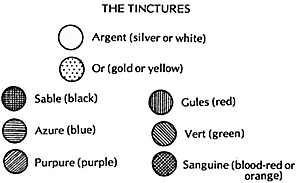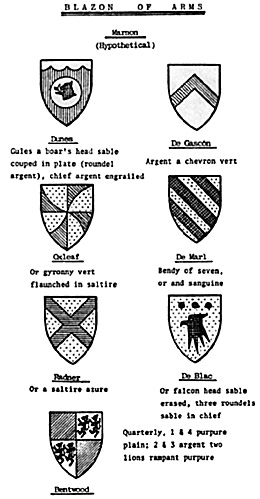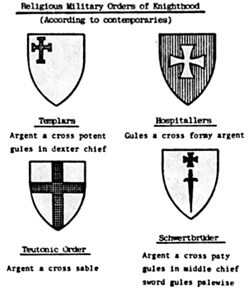BATTLE OF KILGARREN
On their return from crusading abroad, the Hospitallers found their castle of refuge in Marnon occupied by the Gascon Free Company. Their only recourse was to expel the occupants, as joining them was against Holy Order principle. In hopes of gaining the Order's support in the future, the Duke of Bentwood dispatched 120 knights, Templars and Teutonic brethern among them, to help the Hospitallers at Kilgarren. When battle was joined, the Order was 180 strong plus their own 120 pikemen. Secular units were commanded by Sir John deMarl, who reentered into Bentwood's service in way of gratitude for getting him freed at Ore Hill. Bentwood stayed behind.
While on the march, along the valley between Ancient Forest and the mountains, the Hospitallers and cleMarl's units were met by deGascon's company in the foothills of Kilgarren. Battle was joined immediately. Both sides fought according to Frankish doctrine. Hospitaller pike (HI) formed a protective screen for the chivalry and advanced with the woods along their right flank. DeGascon stood across their path, with archers in the center and cavalry on both flanks. An outflanking maneuver by the Gascon knights was successful. Not having enough infantry to form a hedgehog defense, the brethern knights were obliged to meet the attack head-on while under fire from Company archers, who had moved into the wood to the Hospitallers' other flank (see Diagram). Their pikemen were pinned in place by the remaining Gascon knights.
DeMarl's division broke under the combined assault of heavy cavalry and arrow barrage. Following in their wake, the entire force retreated leaving behind 60 pikemen and 80 knights dead on the field. It was a milestone victory, establishing the Gascon Free Company's reputation and forcing all Religious Military
Orders to share the Templar castle at Hempen Rook in the future, now that Gaudy and Kilgarren were both lost.
Author's Note-Because of the small number of troops involved, we used 10:1 figure ratio instead of the normal 20:1 and found it resulted in a better looking field for this meeting engagement.

MARNON DIVIDED
The unfortunate Duke of Bentwood saw his duchy split by ambition, treachery and mistrust into several factions under Henry. With no hope of regaining control, he fled Marnon before the end of June. The newly established Principality was unstable. In addition to the ever-present Tatar threat, three opposing factions were at odds in their purpose: Prince Henry was in the Northwest; deMarl and other Bentwood supporters were in the East, and the Gascon Free Company stood between them. At the time of Bentwood's departure, Marnon military disposition was as follows: (each faction was now represented by one of the 4 players -see Map of Marnon):
COMMENTS CONCERNING HI PIKE UNIT
From the beginning of the Marnon Campaign, we fielded a unit of heavy infantry armed with short pikes (long spears?), in full armor and equipped with kite shields. This was to be an experimental, "what if", formation not normal to the 13th century. The first recorded use of pikes in medieval Europe was in 1302 at Courtrai. Normal use of the weapon was by light to medium troops who wielded the pike with both hands and carried no shield.
| Unit Location | Unit Size | Unit Type | Morale Class | Description |
|---|---|---|---|---|
| PRINCE HENRYS FACTION (740) | ||||
| Castle of Dunes | 400 | Ll | M | Feudal levy |
| 180 | Ml | R | Spearmen | |
| 160 | Ll | M | Garrison archers | |
| BENTWOOD'S FACTION (600) | ||||
| Bentwood Castle (Sir John deMarl)) | 80 | HC | R | Knights |
| 40 | HC | v | Knights | |
| Flint Castle | 80 | LI | M | Feudal archers |
| Hempen Rock | 120 | HC | E | Military Orders |
| Fernham Castle (Sir Geo. Radner) | 200 | HI | v | Pikemen |
| 80 | Ll | M | Feudal archers | |
| GASCON FREE COMPANY (360) | ||||
| Castle Kilgarren (Mont. deGascon) | 160 | HC | E | Knights |
| 200 | Hl | R | Archers | |
| TATAR FORCES (960) | ||||
| Oxleaf Castle (Toghrul Khan) | 280 | LC | E & R | Horse archers |
| 180 | LC | v | Tribal spear | |
| Gaudy Castle (Jesugai) | 220 | MC | v | Combined arms |
| Island Harbour* (Barak) | 280 | LC | R | Tribal archers |
| *Also guarding bridges across Amnon r. | ||||
In evaluating the unit's strengths and weaknesses, we must recognize its limitations as an offensive weapon. In defense, however, it proved to be virtually unshakable. An interesting aspect of the former circumstance is exemplified in the recent Battle of Ore Hill, where the highly maneuverable enemy cavalry avoided the pikemen rendering them little more than useless. Unbeatable though they may be, effective use could be difficult to come by in some circumstances. The unit's part in the siege tower assault against Oxleaf Castle (previous article) was well conceived as long as archery support could be sustained.
Once the light archers were driven off and the heavy infantry left in melee, the effectiveness of their primary weapon-the pike-had also been lost. In all cases, however, their ability to survive was outstanding. Had they been alloted a lesser than Veteran morale status, it is doubtful whether that quality would have suffered to any appreciable degree. Their armor and close formation seemed more effective than the pike they were armed with. There is little doubt that, fighting several ranks deep, in sufficient numbers and given protected flanks, this unit could not be easily defeated by any opposition extant in the 13th century.
RECAPITULATION OF THE EVENTS OF 1232
2 March - Battle of Ore Hill reestablishes Tatar position (deBlac taken, Timur killed).
late March - Treaty of Oxleaf and Tatar occupation of Whispery Meadow and northern Golden Dunes.
6 April - Marnon become a Principality under Sir Henry, Prince of Dunes (the fall of Bentwood).
23 April - Formation of the Gascon Free Company.
7 June - Battle of Kilgarren.
late June - Duke of Bentwood flees Marnon.
Considering the events above, it is timely to record the Arms of the influential Marnon nobility, for those interested in heraldry, as some may be threatened with extinction if recent trends of the campaign continue! The most important ones are shown below, in traditional tincture hatching and using contemporary Anglo-French terminology in the Blazon of Arms.



More Marnon Part 3
Marnon
- Marnon Campaign Part I
Marnon Campaign Part II
Marnon Campaign Part III
Marnon Campaign Part IV
Marnon Campaign Part V
Back to Table of Contents -- Courier Vol. IV #4
To Courier List of Issues
To MagWeb Master Magazine List
© Copyright 1983 by The Courier Publishing Company.
This article appears in MagWeb (Magazine Web) on the Internet World Wide Web.
Other military history articles and gaming articles are available at http://www.magweb.com